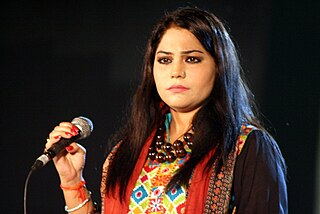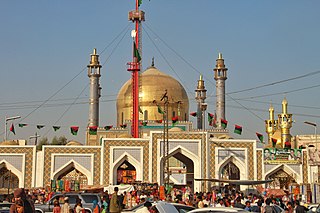Related Research Articles

Sindh is a province of Pakistan. Located in the southeastern region of the country, Sindh is the third-largest province of Pakistan by land area and the second-largest province by population after Punjab. It is bordered by the Pakistani provinces of Balochistan to the west and north-west and Punjab to the north. It shares an International border with the Indian states of Gujarat and Rajasthan to the east; it is also bounded by the Arabian Sea to the south. Sindh's landscape consists mostly of alluvial plains flanking the Indus River, the Thar Desert in the eastern portion of the province along the international border with India, and the Kirthar Mountains in the western portion of the province.

The Indus Valley Civilisation (IVC), also known as the Indus Civilisation was a Bronze Age civilisation in the northwestern regions of South Asia, lasting from 3300 BCE to 1300 BCE, and in its mature form 2600 BCE to 1900 BCE. Together with ancient Egypt and Mesopotamia, it was one of three early civilisations of the Near East and South Asia, and of the three, the most widespread. Its sites spanned an area from much of Pakistan, to northeast Afghanistan, and northwestern India. The civilisation flourished both in the alluvial plain of the Indus River, which flows through the length of Pakistan, and along a system of perennial monsoon-fed rivers that once coursed in the vicinity of the Ghaggar-Hakra, a seasonal river in northwest India and eastern Pakistan.
ʿAbd al-Rahman al-Sufi was an iranian astronomer also known as ʿAbd ar-Rahman as-Sufi, ʿAbd al-Rahman Abu al-Husayn, ʿAbdul Rahman Sufi, or ʿAbdurrahman Sufi, historically, in the West as Azophi, Azophi Arabus, and Albuhassin. Al-Sufi published his famous Book of Fixed Stars in 964, which included both textual descriptions and pictures. Al-Biruni reports that his work on the ecliptic was carried out in Shiraz. He lived at the Buyid court in Isfahan.

The Book of Fixed Stars is an astronomical text written by Abd al-Rahman al-Sufi (Azophi) around 964. Following the translation movement in the 9th century AD, the book was written in Arabic, the common language for scholars across the vast Islamic territories, although the author himself was Persian. It was an attempt to create a synthesis of the comprehensive star catalogue in Ptolemy’s Almagest with the indigenous Arabic astronomical traditions on the constellations. The original manuscript no longer survives as an autograph, however, the importance of tradition and the practice of diligence central to Islamic manuscript tradition have ensured the survival of the Book of Stars in later-made copies.

Baltistan also known as Baltiyul or Little Tibet, is a mountainous region in the Pakistani-administered territory of Gilgit–Baltistan. It is located near the Karakoram and borders Gilgit to the west, China's Xinjiang to the north, Indian-administered Ladakh to the southeast, and the Indian-administered Kashmir Valley to the southwest. The average altitude of the region is over 3,350 metres (10,990 ft). Baltistan is largely administered under the Baltistan Division.

Data Darbar, located in the city of Lahore, is the largest Sufi shrine in South Asia. It was built to house the remains of Ali Hujwiri, commonly known as Data Ganj Baksh, a Sufi saint from Ghazni in present-day Afghanistan, who is believed to have lived on the site in the 11th century CE.

Ali Azmat Butt is a Pakistani singer-songwriter, musician and actor. He is best known as the lead singer for the influential Sufi rock band Junoon and for his subsequent solo career later followed by a career as an actor as well.

Rexheb Beqiri, better known by the religious name Baba Rexheb, was an Albanian Islamic scholar and Sufi. He was the founder and the head of the Bektashi Sufi lodge (tekke) located in Taylor, Michigan, United States.

Alfred Vincent Kidder was an American archaeologist considered the foremost of the southwestern United States and Mesoamerica during the first half of the 20th century. He saw a disciplined system of archaeological techniques as a means to extend the principles of anthropology into the prehistoric past and so was the originator of the first comprehensive, systematic approach to North American archaeology.
Gregory Louis Possehl was a professor emeritus of anthropology at the University of Pennsylvania, United States, and curator of the Asian Collections at the University of Pennsylvania Museum of Archaeology and Anthropology. He was involved in excavations of the Indus Valley civilization in India and Pakistan since 1964, and was an author of many books and articles on the Indus Civilization and related topics. He received his BA in anthropology from the University of Washington in 1964, his MA in anthropology from the University of Washington in 1967, and his PhD in anthropology from the University of Chicago in 1974. He conducted major excavations in Gujarat, Rajasthan (Gilund), and in January 2007, began an excavation at the UNESCO World Heritage site of Bat in the Sultanate of Oman.

Sehwan is a historic city located in Jamshoro District of Sindh province in Pakistan and on the west bank of the Indus 80 miles (130 km) north-west of Hyderabad. The city is renowned for being home of one of Pakistan's most important Sufi shrines, the Shrine of Lal Shahbaz Qalandar.The city also holds the status of taluka under Jamshoro District. It was previously under Dadu District however, after establishing the Jamshoro District, Sehwan was linked with Jamshoro District.
The Margaret Mead Film Festival is an annual film festival held at the American Museum of Natural History in New York City. It is the longest-running, premiere showcase for international documentaries in the United States, encompassing a broad spectrum of work, from indigenous community media to experimental nonfiction. The Festival is distinguished by its outstanding selection of titles, which tackle diverse and challenging subjects, representing a range of issues and perspectives, and by the forums for discussion with filmmakers and speakers.

The Asian Cultural Council (ACC) is a non-profit organization dedicated to advancing international cultural exchange between Asia and the U.S. and between the countries of Asia through the arts. Founded by John D. Rockefeller III in 1963, ACC has invested over $100 million in grants to artists and arts professionals representing 16 fields and 26 countries through over 6,000 exchanges. ACC supports $1.4 million in grants annually for individuals and organizations.
Minal Hajratwala is a writer, performer, poet, and queer activist of Indian descent. She was born in 1971 in San Francisco, California, US, and was raised in New Zealand and suburban Michigan. She is a graduate of Stanford University.
Sadia Quraeshi Shepard is a Pakistani American filmmaker and author. She is the author of The Girl from Foreign: A Search for Shipwrecked Ancestors, Lost Loves, and a Sense of Home, which was published by the Penguin Press in 2008. She is the daughter of an American father, architect Richard Shepard, and a Pakistani American mother - artist, designer and educator, Samina Quraeshi.

Mary Tyler Mann was a teacher, author, and mother. She was the wife of Horace Mann, American education reformer and politician.

Sanam Marvi is a Pakistani folk and sufi singer. She sings in Sindhi, Punjabi, and Balochi languages.

Dancing Girl is a prehistoric bronze sculpture made in lost-wax casting about c. 2300–1750 BC in the Indus Valley civilisation city of Mohenjo-daro, which was one of the earliest cities. The statue is 10.5 centimetres (4.1 in) tall, and depicts a nude young woman or girl with stylized ornaments, standing in a confident, naturalistic pose. Dancing Girl is highly regarded as a work of art.

The Shrine of Lal Shahbaz Qalandar is a shrine and mausoleum dedicated to the 13th century Muslim and Sufi saint, Lal Shahbaz Qalandar. The shrine is located in Sehwan Sharif, in the Pakistani province of Sindh. The shrine is one of the most important in Pakistan, and attracts up to one million visitors annually.
References
- ↑ Rapp, Alan. "Samina Quraeshi biography". AIGA Design Journeys.
- ↑ Walsh, Colleen (15 October 2009). "Islam's mystical dimensions take flight". Harvard Gazette.
- ↑ Fash, W. Barbara. "New Releases: The Copan sculpture museum". Peabody Museum Press.